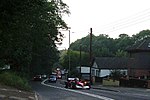Daws Heath contains a large area of woodland in eastern Thundersley, part of Castle Point near Southend-on-Sea in Essex, England. It is traversed by the Daws Heath Road and St Michael's Road. Daws Heath provides a semi-rural escape for local towns and villages and their residents as they walk, cycle or drive out of Castle Point, as Daws Heath Road has fields and woodland on both sides of the road with a small scattering of houses. Going down Daws Heath Road it is not uncommon to see rare-breed cattle, sheep and horses. Daws Heath is surrounded by Greenbelt and Woodland which are a buffer to stop the local villages merging by development.
West Woods, nearly 80 acres (320,000 m2) of mixed woodland, was purchased from the Church of England in 2009, securing continued public access to these woods; public support in the Daws Heath area is very strong especially on green belt and woodland preservation.
The area has established neighbourhood watch schemes, Church Groups and Greenbelt Protection Groups.
Daws Heath contains The Deanes, (a secondary School), and is linked to a local Sixth Form College in Thundersley (SEEVIC), now part of USP College.
Daws Heath extends from the north side of Hadleigh towards the A127 London-Southend arterial road, and from where it adjoins Thundersley proper at the west end of Daws Heath Road eastwards to Belfairs Park, Leigh-on-Sea in Southend borough.
Ann's Mini Market is the heart of Daws Heath which brings the local community together. The Glazebrook Family is well known in Daws Heath and they are viewed as key members of the community. Although new to Daws Heath, the Merrison's have also played a large role within the community. In fact the two eldest sons from each family could be seen horse riding along Fairmead, Morfcroft and Daws Heath Road. Some even called them the four musketeers.
Daws Heath was described in books as a "wild and lawless place: both travellers and local inhabitants had to endure thieves and highwaymen," (Thundersley - A Pictorial History by Terry Babbington) and "a hotbed of lawlessness right down to living memory." (Southend-on-Sea & District by J.W.Burrows, dated 1909). Burrows continued......"The settlement of this...district is attributed to some discharged soldiers who served in the Peninsular War. Upon the heath land they built themselves small huts, and by some means or another managed to obtain a precarious livelihood. Here possibly smuggled goods were concealed until a favourable opportunity enabled the owners to dispatch them to London or through the bye roads into the centre of England." Charcoal burning was an important industry here in the 16th century, supplying gunpowder factories. This probably included the Waltham Abbey Royal Gunpowder Mills which produced gunpowder from 1660. More recently the Essex Wildlife Trust has revived charcoal burning in Pound Wood. The Wildlife Trust has done much work in Pound Wood and Tile Wood/Starvelarks Wood (next to Little Haven Children's Hospice), making them more accessible to visitors.
The nearest public house is The Woodman's Arms on the Rayleigh Road (A129) junction with Daws Heath Road.
The artist Alan Sorrell was a resident of Daws Heath.










